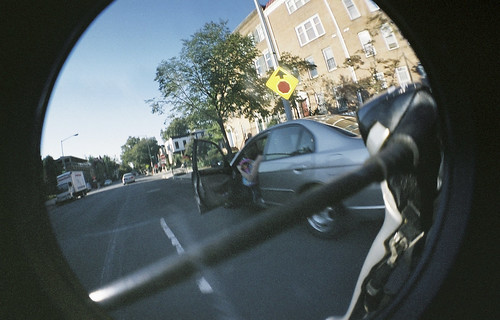 photo: Bike to work by e.wilder
photo: Bike to work by e.wilderLast week a car door gave me a lesson in NLP. The cyclists among my readers will already be sighing...
It was Tuesday morning, I was pumping up a steep hill working desperately to get my daughter Jyoti to school on time. Then with a timing I could not avoid a man in a smart car opened his door. Pieces of bike cracked off as we skidded and fell to the left.
My body and the wrong part of my training took over. I had hardly hit the ground and I was up again. There were no cars or buses about to crush us and my daughter seemed unhurt. In front of me was a an open car door inside of which was the target of 15 years of bottled cycle rage. My right fist felt like it could smash metal, and there was an open line between it and the scared face of the driver. My lungs were supplying plenty of volume to a mix of obscenity, incrimination and threat. The driver shrank in his seat.
I do not know how long I stood there, perhaps two or three seconds, but it felt a long time.
A better part of my training took over. I saw fear and regret on the driver's face. I was aware of passer's by coming to help, my daughter was crying. I turned to lift her off her bike seat and comfort her.
Jyoti was ok, my bike was mostly ok. The passer's by brought the pieces of bike that had flown off on impact. The driver, upset, went to hug my daughter as I held her. I let him.
Jyoti told me she was fine to get back on the bike. We even managed to get to school on time. As we pedaled off I saw that the driver was having trouble shutting his car door.
Later as I thought about what happened I felt a little ashamed. Yes I looked behind and saw my daughter was Ok, but I tended to my rage before I tended to her well being.
I understand how I did that. I have been an urban cyclist almost daily for since the early 1990's. Many times I have nearly been killed and injured by the thoughtlessness of people piloting 1000 kg steel clad fists through the streets. Most of the time it was just thoughtlessness, lapses of awareness, moments of carelessness. Occasionally it has been malicious, people deliberately cutting close, swerving and aiming for me.
Insulated in their steel fist most drivers do not think of what is like to be on a flimsy wheeled frame powered by lungs and thighs, seeking the safest route between unfeeling obstacles.
When some coddled driver, in their impatience and thoughtlessness nearly kills you, it is hard not to take it personally. As a result I built up layers of self justification.
I had created a scenario where at last I would be able to express my righteous anger....
...Not nearly hit this time, but hit. The driver would be out of their armored casing, they would have already struck the first blow, and at last I would be able to strike some back. Self defense, clearly, little me armed only with my hands (elbows, knees, head and possibly a D-lock), against 1000kg fist man. Every blow would come straight from my belly, a whole body communication saying: PAY ATTENTION TO CYCLISTS
Variations include disarming my attacker by throwing their car keys down the nearest drain.
That is what I had been rehearsing mentally. It is nearly what I did. the pained shock on the driver's face is what stopped me. If he had been aggressive he probably would have been toast.
The positive intention in my hitting back scenario clear. But is hitting people the best way to get the message across - pay attention, drive safely, respect the fragile, fleshy two wheelers?
Every time I got a little satisfaction from imagining demolishing a dangerous car I was making it a little more likely to happen. Rehearsing this way I was loosing flexibility in getting my real message across, and putting myself in a legally dangerous position. I was also filling my body with stress hormones and missing out on what is actually happening and important (like bad driving), and what I might take pleasure in, people, weather, light.
So I am going to change my mental rehearsal with cycling. Change it from some fixed scenario, to remembering what I consider important. I will rehearse the qualities that allow me to say 'we are all human, let's look out for each other, and maybe even have some fun.' I will rehearse awareness in the place of rage. This is something my life depends on, literally. Fortunately, I am well trained to do this.
It is more than just cycling. I am also looking out for all the other unhelpful scenarios I am rehearsing. Lots of relationship arguments are based on this kind of imagined scenarios 'if she says this I am going to lose it...'
How many other stupid situations will I be able to avoid and turn into possibilities for pleasure? That is all very well for me, what about you?



























